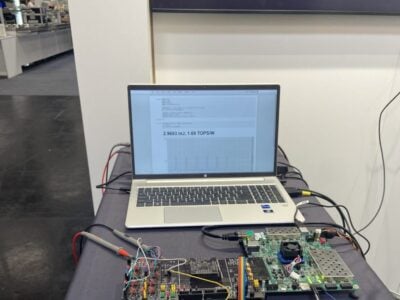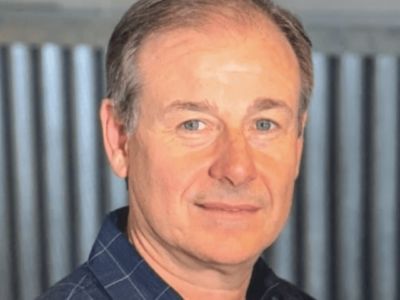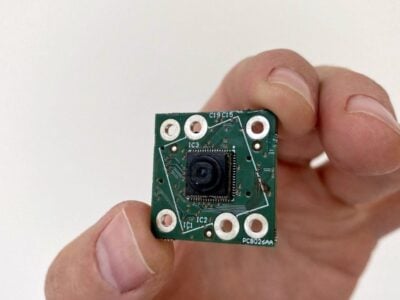
The chip shortage has been good to Mouser Electronics as a global distributor even in the midst of a global pandemic.
“Our business has gone through the roof and it seems like there’s no ceiling,” said Mark Burr-Lonnon, Senior vice president of EMEA, Asia and Global Service at Mouser Electronics (above, right). “Globally bookings are up 50 percent and billings up 32 percent, with European billings up 48 percent. Some of that is due to laying in a lot of inventory, and the risk of allocation and long lead times helps distribution. But it’s also the whole move to the digitalisation of the supply chain that is also driving the growth.”
Mouser is part of the privately-held TTI group, which has also seen significant changes in the last few months. In February Paul Andrews, TTi’s founder and CEO passed away, with chief operating office Mike Morton taking over. The strategy of the group has been to provide inventory and supply chain management, particularly for semiconductors where Mouser competes with Digi-Key, Farnell and Electrocomponents (RS).
Inventory
“The TTi group view is that inventory is very important,” said Burr-Lonnon. “We’re not on the stock exchange where we don’t have to report quarterly figures. This means we can do the right thing to make sure we have the right inventory at the right time – we’ve heavily invested hundreds of millions of dollars in extra inventory in recent years so we were well prepared. We had $800m on the shelf and $500m on order, and our inventory is based on being wide, its there for everyone.”
Mouser deliberately took a different approach to two of its competitors. “Other companies heavily invest in sales people – we haven’t done that. We need to bring people to the inventory and if there’s no inventory that’s not good so when an engineer is doing a new design, we make sure we have the widest selection as he’s only interested that you have the part.”
This is a key point, says Graham Maggs, Vice President Of Marketing And Business Development EMEA (above, left).
“There is this understanding in Europe that goes back many years that disties hold inventory, but they don’t, they buffer inventory,” said Maggs. “The change seven or eight years ago meant the e-commerce model could have free stock available and is able to support designs.”
Mouser capitalised on this. “We have that very large inventory with 1m part numbers ready to ship today in one location in north Texas that allows us to ship in 1-2 days adding an extra day for routes that are so busy, so when an engineer is buying a bill of materials (BoM) with 20 to 100 parts we can ship all of that in one box with one invoice,” he said.
Pandemic response
This centralised warehouse approach was potentially vulnerable to the Covid-19 pandemic in the US.
“The biggest challenge was to have sufficient staff in the warehouse so we increased the number of shifts with more people in each shift, and that meant that each group could cope,” said Maggs. “We zoned the warehouse so if there was a case we could disinfect a zone – that enabled us to keep going as it got to the point of impossible not to have cases.”
This was helped by the fact additional warehouse space was built at the end of 2019, moving into a bigger area with more facilities and adding automation with vertical lift modules (VLM) that helped increase the capacity and speed up access to parts. “Since then we have been increasing automation wherever we can to ensure that we are able to manage the volume of business and the security of staff,” said Maggs.
“We had to build in inefficiencies to keep people safe – we are really keen to get out of Covid to get more efficiencies,” said Burr-Lonnon.
The company is seeing the recovery in Europe in the German (DACH) region, supplying designers in automotive and industrial automation companies. “We don’t supply in high volume – we supply the design engineers on the new products, not production,” said Burr-Lonnon. “The electronics and semiconductor supply chain is not really a last minute buy and I think the auto industry has learnt they have to come into line with the people that supply a huge amount of value in the car especially as it moves to EV. For example, we had a call from a major US manufacturer about the supply chain. We would never normally have that discussion about supply chain with a car manufacturer.”
“From a supply standpoint the allocation has the potential to go through the year – a lot of parts may be easier to get but the market will be in undersupply for a lot of this year, there’s no sign of it slowing down right now, it’s just crazy. Some will come out of this earlier than others.”
Semiconductor cycle
Both are experienced semiconductor industry executives who have seen the cycle several times.
“History tells us there’s a boom followed by a bust but this time it might be slightly different,” said Burr-Lonnon. “There is so much more new technology, everyone is designing with new technology and 5G will have a huge impact, so I don’t think there will be a huge drop off.”
“Its not necessarily the growth that’s the issue,” said Maggs. “You have many different markets with new technologies driving new products that are requiring components, MLCC capacitors are everywhere, chokes, wherever you look components are in demand. In Asia it’s consumer and there are shortages there. I remember the telecoms industry drop was terrible but it came back after about 18 months – this is likely to be a bit longer,” he said.
“The difference for Mouser is the growing the number of customers, with engineers working in every kind of environment, that’s why we can take the highs and take the lows so even when times get difficult we have inventory and we keep it going,” said Maggs.
FAEs
There is also a fundamental change with less need for field applications engineers, they say. “Most engineers tend to look on the web first [for parts] and some of the semiconductor suppliers look at that data, but most designs started with an ecommerce platform where they start fiddling with the parts and that becomes a design later,” said Burr-Lonnon. “There’s a lot of designs that start a long time before an FAE starts to get involved.”
“The FAE is one area that has seen a decline in the market,” said Maggs. “An FAE from a semiconductor vendor talks about one product.”
“Theres no semiconductor company that can offer everything – the engineer still needs connectors, capacitors, switches, They are making themselves more preferred with a wider range but that helps us with the ranges that we have,” said Burr-Lonnon.
Planning for Brexit
Brexit has also not been an issue he says.
“We used to ship everything via Paris so it was easy to fix,” said Burr-Lonnon. “One batch goes to Paris and the other to Stansted but its worked well – its probably easier shipping things in from the US.”
“Today with Brexit we were ready for it and planned for it,” said Maggs. “We did upset a few customers but the system has been easier to implement than shipping products from the UK to Europe. The first few weeks the problems were paperwork then it was workloads with customs – they are getting on top of that so most of the issues were beyond our control.
Related distribution articles
- A perfect storm for European distribution
- Digitising distribution
- Downturn in German components distribution ends
- Anglia launches API for its distribution database
Other articles on eeNews Europe
- IBM shows first 2nm chip
- BMW winning race to solid state battery electric car in 2022
- Breakthrough for room temperature optical quantum computing
- Zigbee Alliance changes name in Matter IoT launch
- UK crypto startup heads to Cayman Islands in $1.4bn deal
- New CTO for Siemens Digital Industries
- €7m for European PCB factories
 If you enjoyed this article, you will like the following ones: don't miss them by subscribing to :
eeNews on Google News
If you enjoyed this article, you will like the following ones: don't miss them by subscribing to :
eeNews on Google News



